Prefabricated Homes Market Insights, 2032
The Global Prefabricated Homes Market size was valued at US$ 20.4 billion in 2022, and is projected to reach US$ 38.9 billion by 2032, growing at a CAGR of 6.7% from 2023 to 2032. A prefabricated house is an offsite construction consisting of parts and modules which are transported and set up on the premises. The manufacturing of these buildings takes place in an industry environment, ensuring a high level of accuracy and quality. A handful of resources used in the manufacture of prefab structures, ranging from floor to walls and roof, are steel, timber or cement. once delivered to the building site, these parts are swiftly pieced together by skilled workers, significantly reducing the construction duration compared to traditional building methods. Prefabricated homes are durable and economical, with customizable options, eco-friendly features, and a wide range of design alternatives.
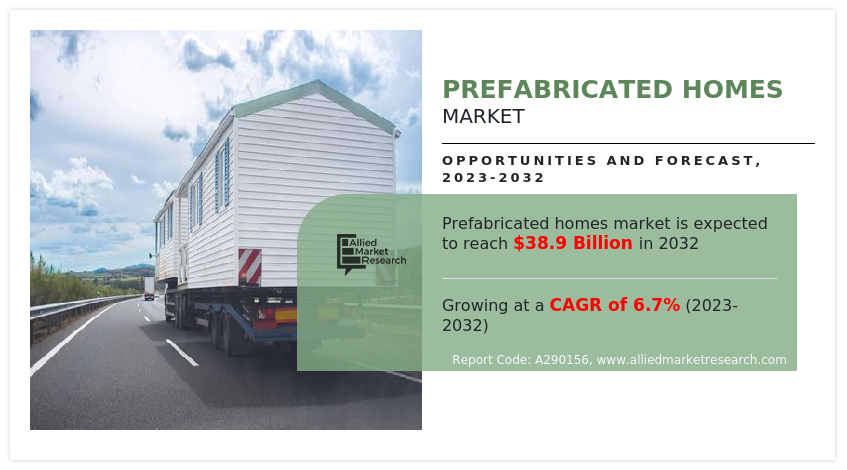
Moreover, prefabricated homes or modular houses and buildings are used in remote areas where conventional construction is not possible. In addition, it has gained popularity, owing to its benefits such as ability to serve remote locations, low waste generation, environment-friendly construction process, enhanced flexibility, high quality, and increased market acceptance.
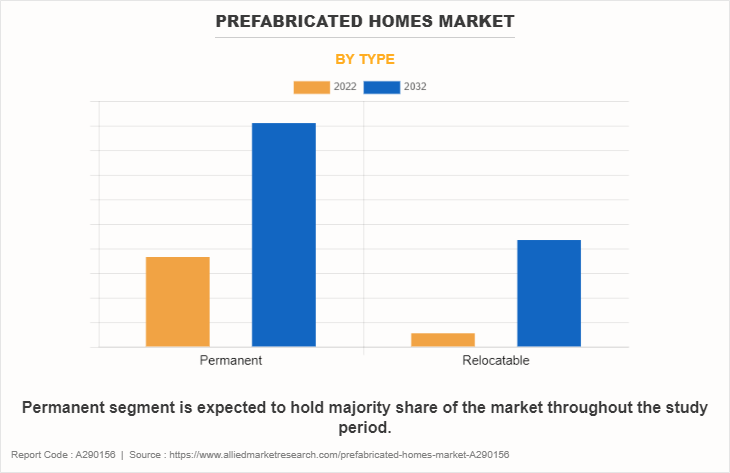
Prefabricated Homes Market dynamics
The global prefabricated homes market growth is driven by increase in industrialization & urbanization in developing countries such as Africa, China, India and others. In addition, upsurge in population is expected to have a direct impact on the growth of the market to cater to the increase in needs of consumers. Additionally, the escalating demand for employment opportunities, housing, energy, clean water, food, transportation infrastructure, and social services is prompting a greater embrace of economical modular building methods that ensure consistent quality. In September 2023, Mighty Buildings, a startup specializing in prefabricated homes using advanced technology and purportedly eco-friendly practices, has disclosed raising $52 million in a funding round. Such trends are expected to drive the prefabricated homes industry.
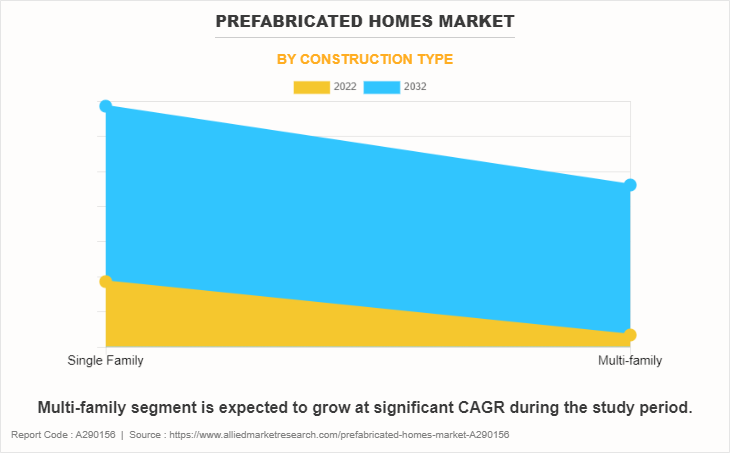
However, lack of reliability on modular construction in earthquake-prone regions considerably hampers the growth of prefabricated homes market. In addition, during the outbreak of the COVID-19 pandemic, construction, manufacturing, hotel, and tourism industries were majorly affected. Construction activities were halted or restricted. This led to decline in market. Conversely, industries have resumed their regular construction and services. This is expected to lead to re-initiation of modular construction companies at their full-scale capacities.
On the contrary, increase in investments in infrastructure is anticipated to offer lucrative growth opportunities for the market players during forecast period.Rise in need for protection of architecture from environmental impacts, increase in government focus on green building concepts, and modular construction for space constraints in large cities are anticipated to drive the growth of the market. In addition, rise in infrastructure spending in various countries, such as Germany, France, India, and others, surges the demand for modular construction, and thus drives the growth of the prefabricated homes market.
A rise in focus toward affordable housing structures and increase in need for modular construction, owing to features, such as quicker build, easy to relocate, and portability, are anticipated to provide lucrative growth opportunities for the market. In addition, urban population has focused on modular construction to afford cheaper living as these containers require less cost as compared to traditional container houses. In October 2023, an Indonesian startup, well-known for its creative modular homes built off-site, has recently completed a series A funding cycle, securing $10 million through a combination of debt and equity investments. In addition, developing countries such as Africa, China, and India, are facing problem for unavailability of houses for migrating population. Such situation is creating demand for prefabricated house which is expected to offer lucrative opportunities for the growth of the prefabricated homes market during the forecast period.
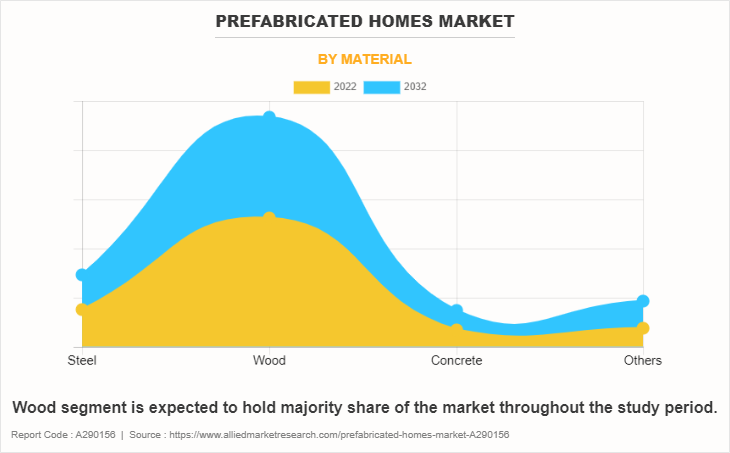
Moreover, initiatives focused on designing, building and putting in place a Green Building concept have been implemented by developing countries like the United States, Japan, Great Britain as well as others. The features that make these prefabricated buildings or modular structures attractive to builders are such as energy efficient and low-cost prefab products for building, which lead to growth of the Prefabricated Housing Market. The growth of the prefabricated homes market is stimulated by factors, including a rise in demand for portable building products from residential and business construction activities with reduced costs and time required to build these buildings.
In addition, due to features such as space issues, mobility problems and ease of transport, the demand for prefab housing is growing thanks to an increasing number of urban populations and industrialization in advanced countries like the US, Japan, France or Canada. The construction of prefab homes is simple and easier to move from one place into another, which drives the growth of the Prefab Home Market.
However, challenges like the shortage of skilled labor and proper infrastructure remain significant obstacles to the market's growth. The lesser popularity of prefabricated home construction in countries like Bangladesh and Cambodia is linked to inadequate road networks. Moreover, installing heating, ventilation, and air conditioning systems in extreme climates poses hurdles that could potentially slow down-market growth.
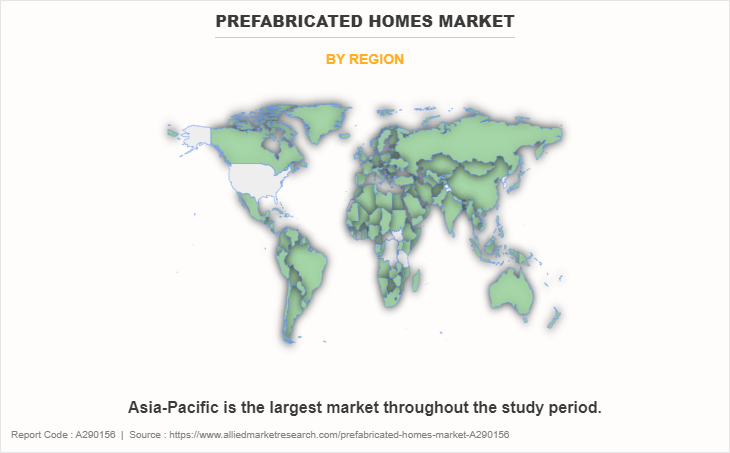
Prefabricated Homes Market Segmentation
The prefabricated homes market forecast is segmented based on construction type, type, material, and region.
Based on construction type, the market is bifurcated into single family and multi family.
Based on type, the market is classified into permanent and relocatable. Based on material, the market is classified into steel, wood, concrete, and others. The concrete segment generated the highest revenue in 2022.
Based on construction type, the multifamily segment dominates the market in 2022.
Based on region, the prefabricated homes market share is analyzed across North America, Europe, Asia-Pacific, and LAMEA. Based on region, North America garnered the highest revenue in 2022; and LAMEA is anticipated to register the highest CAGR during the forecast period.
Competition Analysis
The major players profiled in the prefabricated homes market report included are Aakash Group, ATCO Ltd., Giant Containers, Inc., Honomobo Corporation Inc., Savills plc, SG Blocks, Inc., Skanska AB, Speed House Group of Companies Limited, Stillwater Dwellings, Inc. and Tempohousing B.V.
Major companies in the market have adopted partnership, business expansion, and acquisition as their key developmental strategies to offer better products and services to customers in the market.
Strategies used by key market players
In January 2023, structures segment of ATCO Ltd. revealed its recent acquisition of Triple M Modular Housing, a prominent maker of factory-built housing located in Lethbridge, Alberta, in North America. Under ATCO Structures, Triple M is expected to function as a specialized housing division specifically within Canada.
In December 2022, SG Blocks, Inc., a prominent company involved in developing, designing, and constructing modular buildings, disclosed today that it has finalized an agreement with a real estate investment firm to acquire approximately 25 acres in Denison, Texas. Upon completion of the transaction, SG Blocks is anticipated to become the exclusive owner of this property.
In May 2022, SG Blocks, a top creator and manufacturer of modular structures using containers for various purposes such as residential, commercial, military, and healthcare projects, extends gratitude to Steve Armstrong, the Chief Technology Officer. Armstrong joined the Tiny House Alliance USA, supporting goal of providing affordable housing. SG Blocks employs two construction methods: their renowned container-based approach and wood-based solutions, aligning with their commitment to affordability, efficiency, and sustainability in every project.
Key Benefits For Stakeholders
- This report provides a quantitative analysis of the market segments, current trends, estimations, and dynamics of the prefabricated homes market analysis from 2022 to 2032 to identify the prevailing prefabricated homes market opportunities.
- The prefabricated homes market research is offered along with information related to key drivers, restraints, and opportunities.
- Porter's five forces analysis highlights the potency of buyers and suppliers to enable stakeholders make profit-oriented business decisions and strengthen their supplier-buyer network.
- In-depth analysis of the prefabricated homes market overview, segmentation assists to determine the prevailing market opportunities.
- Major countries in each region are mapped according to their revenue contribution to the global prefabricated homes market.
- Market player positioning facilitates benchmarking and provides a clear understanding of the present position of the prefabricated homes market players.
- The report includes the analysis of the regional as well as global prefabricated homes market trends, key players, market segments, application areas, and market growth strategies.
Prefabricated Homes Market Report Highlights
| Aspects | Details |
| Market Size By 2032 | USD 38.9 billion |
| Growth Rate | CAGR of 6.7% |
| Forecast period | 2022 - 2032 |
| Report Pages | 220 |
| By Type |
|
| By Construction Type |
|
| By Material |
|
| By Region |
|
| Key Market Players | SG Blocks, Inc., Skanska AB, Speed House Group of Companies Limited, Stillwater Dwellings, Inc., SAVILLS PLC, Aakash Group, ATCO Ltd., Giant Containers, Inc., Tempohousing B.V., Honomobo Corporation Inc. |
Analyst Review
Prefabricated home construction is used in prefabricated home construction, restrooms, bathrooms, workplace housing, bathrooms, bedrooms, and entire buildings. The expansion in requests for prefabricated construction, primarily due to the affordability of housing structures, propels the advancement of the prefabricated home market. An increase in the need for prefabricated home construction materials is seen because of cost and time reductions in building, convenient installation, and limited space availability in major urban areas. Consequently, this surge further fuels the expansion of the prefabricated home market.. Increase in focus toward affordable residential spaces has significant impact on the market growth. Moreover, prefabricated home construction buildings have been developed using wood, steel, composite material, concrete, and other materials that protect from changes in external environment and are easy to install & relocate.
As more people move from rural to city areas, there's a growing need for shopping centers and pre-built homes. This trend could really help the prefabricated home market to grow.
However, concerns remain as to how reliable prefab housing is in earthquake prone areas and the lack of skilled workers in developing countries. The growth in the prefab housing market could be slowed down by these concerns. On a brighter note, increased investments in infrastructure could create great opportunities for the prefabricated home market to flourish.
The global prefabricated homes market was valued at $20,347.2 million in 2022, and is projected to reach $38,917.5 million by 2032, registering a CAGR of 6.7% from 2023 to 2032.
The forecast period considered for the global prefabricated homes market is 2022 to 2032, wherein, 2022 is the base year, 2023 is the estimated year, and 2032 is the forecast year.
The latest version of global prefabricated homes market report can be obtained on demand from the website.
The base year considered in the global prefabricated homes market report is 2022.
The major players profiled in the prefabricated homes market include Aakash Group, ATCO Ltd., Giant Containers, Inc., Honomobo Corporation Inc., Savills plc, SG Blocks, Inc., Skanska AB, Speed House Group of Companies Limited, Stillwater Dwellings, Inc. and Tempohousing B.V.
The top ten market players are selected based on two key attributes - competitive strength and market positioning.
The report contains an exclusive company profile section, where leading companies in the market are profiled. These profiles typically cover company overview, geographical presence, market dominance (in terms of revenue and volume sales), various strategies, and recent developments.
Based on material, the wood segment was the largest revenue generator in 2022.
Loading Table Of Content...
Loading Research Methodology...



